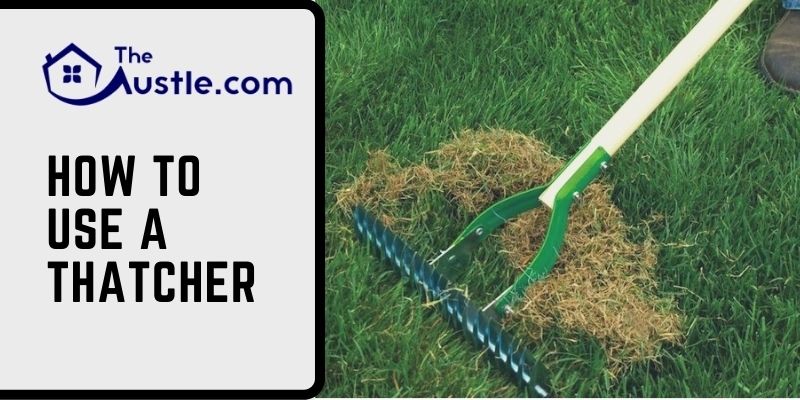Do you want to know how to use a Thatcher? Thatch is a layer of roots, stems that accumulations at the soil surface of your lawn. Thatching can improve your lawn’s health and provides a more pleasant yard as you want.
When your lawn is brown under a green surface, or may it looks dead, then you may need to thatch. There are some essential tips and tricks on how to use a thatcher if you have problems with thatch or infected soil on your site.
How To Use a Thatcher In Details
A thatcher knew as a dethatcher or a vertical mower. It is used as a layer of living and dead plant stems, roots, and other parts deposited in the soil surface and grass blades.
The lawn care, thatch, is a layer of organic matter which gathers on a lawn around the grass plant’s base. The main form of lawn thatcher is a thatching rake. A long-handled hand tool with a blade that can be pulled from the grass as the lawn is spread.
Don’t worry; you can use it for larger areas of grass. You can purchase or rent thatcher. It also looks like a lawnmower. These tools are sometimes provided as power rakes. There are three primary thatching materials used on roofs.
- Combed Wheat Reed
- Long straw
Here, also, the thatcher can move across the roof as well as up or down it. Thatcher has developed some smart device to make full of this fact.
When Dethatching is Required
When a turf area underfoot feels spongy and feels dry even with enough watering, you must understand that it is excess if you notice that the area shows disease or insect or problems that use as you may have more thatch.
Whenever you need to detach it, you can dig up a small wedge of soil from many parts of the lawn. And through the brownish thatch layer into the soil surface and green part of the grass blades. When you check the layer is more than 1⁄2 inch dense, then you need to detach.
Is it Good or Bad?
Here, you can say that thatch is the best in moderation, as a majority of things in life. The thatcher can beneficial for a yard when the thin layer is less than ½ inch. It helps with set apart from excessive temperatures and foot traffic.
Besides that, by reducing weed germination and helping retain soil moisture. Thatch also can helpful on sports turf because it boosts elasticity and softens the impact.
On the contrary, extreme thatch can cause various issues. Most of the time, thick layers can shelter pests and diseases and trap roots in the layer. Excessive thatch can limit the ability of Oxygen, Water, and Insecticides.
When the layers of thatch are thick, then the mower scalp can occur. Grass crowns that grow in molds also build on the ground, which puts them at risk of scarring.
How to Use a Thatcher
Thatcher comes in various forms, like rake tools, to pull out and loosen the layer. On the other hand, mechanical thatcher comes in models that look like vertical mowers.
Using a thatching rake
A thatching rake is reasonable at a small lawn. It has thick blades that are model to dig into the turf and loosen the thatch layer.
- Drag the thatching rake across the lawn bring pruning under the ground.
- Diverge and discard the ruins.
Using a vertical number
When the lawn gets large, then you should use a vertical mower to cut through the soil surface. This mower has rolling blades that quickly reduced the thatch and brought it to the surface.
The depth of where the vertical blades enter is adjustable, and this should be destined by the thickness of the thatcher. You can find it rental equipment center.
- For cluster grass, set the blade higher apart.
- efore detached, mow your turf area a little lower than you can lightly wet the soil surface.
- Drive the vertical across the lawn in the direction.
- Dismiss the ruins with a rake.
- According to fertilizing, when water as needed.
Benefits on How to Use a Thatcher
Here, provide various benefits to thatch your lawn. Read below to learn all about the benefits of thatching
-
Root growth healthier
Without healthy roots, the grass can never be green, full, and thick. By thatching can improve to circulate air and help the importance of Carbon dioxide while inspiring new root growth.
-
More effective fertilizer
By removing thatch, it helps fertilizer mix more appropriately with the soil and spread through the lawn. The lawn gets more effective fertilizer because of thatching work.
-
Effective draining
in the rainy season, thatch blocks the drainage from the top of the grass. When the thatch is present, it provides the soil for a more extended period.
Don’t worry; thatching will get your lawn successfully drain while bringing its growth.
Frequently Asked question
Ques: What is thatch?
In lawn care, there is a layer of organic matter around the grass plant’s base. It also a combination of living and dead plants with crowns, rhizomes, and roots.
Ques: Is power raking essential?
Thatching and power raking are essential when you have dead thatch in your lawn, which is smothering or keeping your good grass from flourishing.
Final Thought
After researching a lot, you finally knew how to use a thatcher with this article. The grass can actively grow, and the soil gets nutritious because of lawn recovery by thatching.
So, you have to know the correctly use of thatcher because of lawn or yard recovering. As you know now, uses of thatcher, so don’t worry, read the above article and check out with everything.

